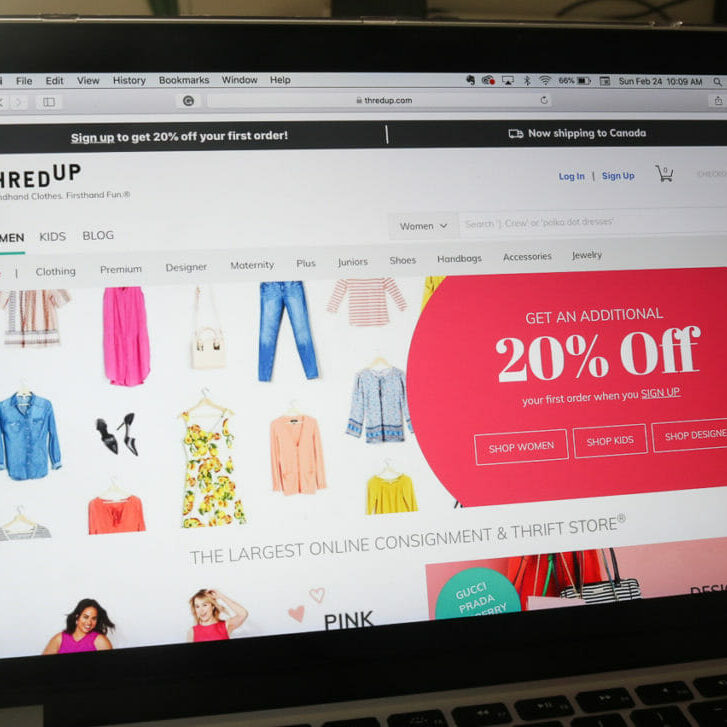
ThredUP misses the point of thrifting
Secondhand clothing? More like sustainability scam
ThredUP is an online shop selling secondhand clothing. Veiled in the rosy rhetoric of sustainability, savings and style, their Facebook page preaches, “get thrifty with it!”
Online thrifting seems like a godsend, and maybe it could be, but thredUP is not it.
No one will deny that reusing clothes is better than tossing them. The concept seems sound. Send in your old clothes instead of throwing them out! Order “another woman’s trash,” which is now your treasure, a garment good as new!
Except thrifting isn’t good as new. And that’s exactly the point.
Strict quality control
You can send clothing to thredUP using their “Clean Out Kit.” Once received, “thredUP’s authentication and style experts determine resale value. Only high-quality items that meet our strict standards will be accepted.”
Strict standards indeed. They don’t accept clothing purchased more than five years ago, items missing sizing information, “outdated denim treatments or pant cuts,” any signs of wear including “rips, tears, pilling, fading, shrinkage or blemishes of any kind.”
I cut the label off my fluffy sweater because it was getting in the way of the fluff. I don’t need the “99% cotton” assurance to prove that it’s still cozy, ready to warm the arms of its next owner.
“Outdated denim treatments or pant cuts?” You’re telling me that low waist flare is outdated?
Kiss my apple bottom ass.
There’s also an emphasis on brand authenticity. They list “brands we love,” they don’t accept fakes or knockoffs of any kind.
The rule I go by: if it’s authentic enough to fool me at the thrift store, it’s authentic enough to fool everyone else. Looking hot in these jeans, feeling crafty because I’m the only one that knows that the “Gucci” on my waistband is missing a “c.”
So, once you’re past the quality standards –– tough luck given they “typically accept less than 40% of the clothing we receive for resale” –– you’re ready to get into the secondhand spirit.
So many things to choose from, passed down from other thredUP users. No new materials, the sustainable cycle of mail-in and receive; who knew that thredUP was the one-stop shop to being on-trend and environmentally conscious!
Well, they’ve barely got the environmentally conscious part.
What happens to the 60 per cent of clothes that aren’t accepted? What about waste from processing and re-packaging clothing? What resources go into transport? These answers can’t be found on their website.
As to being on-trend, the word “trend” refers to “what’s hip or popular at a certain point in time.” What’s trendy now probably wasn’t five years ago, and won’t be trendy five years from now.
Interesting how brands and celebrities avidly push trends forward. It’s almost as if they keep changing the “standards of cool” so that we are forced to buy continuously.
They set what’s cool, and they sell it too. It’s like asking your barber if you need a haircut.
Point is, trends are a tool to tempt your purchase. That everyone else has one, that a celebrity was spotted in it, that it’s just so freaking edgy if not comfortable or practical, is a reason to buy something you might not buy otherwise. The temporariness of trends is part of their definition, and trendiness is clearly not sustainable.
Trends aren’t always evil all the time. There are other reasons for wasteful consumption, like convenience or necessity but thinking about why something is trendy, the importance of being “on-trend” might change how you buy.
Nothing new
ThredUP isn’t the first secondhand clothing company. Consignment and vintage shops are plenty to be found. Rather it’s suspicious that thredUP is marketing sustainability, while also marketing trendiness. If trendiness leads to money flow, we can guess where thredUPs priorities lie.
Sustainability is a checkbox, a term that they are stamping on their company and products to – ironically –– hop on the eco-friendly trend. Meanwhile, they ignore the main issue, the focus on brand and trend is an unsustainable way of thinking.
Experienced thrifters know to check for pit and crotch stains, test each zipper, watch for loose seams or holes, and the list goes on.
But even if something sounds the alarm, it’s not over. A thread and needle, hefty scissors, clothing die, or patches might be a quick fix.
Grossed out by pit and crotch stains? Well I can’t say I don’t have a few clothes with those. Sometimes a brief outline is left even after multiple attempts to remove it. Ah well, it’s still wearable, you can’t see the stain from the outside, and there’s no ghost of past crotch stain haunting the garment with the smell of my period from three years ago.
If it’s a freshly laundered and recent addition to my closet, it’s new to me.






